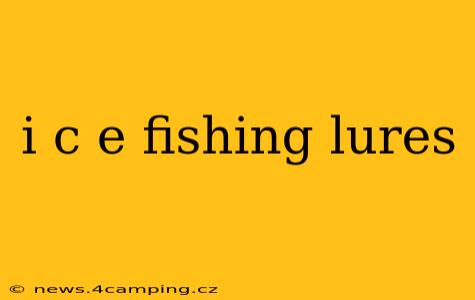Ice fishing presents unique challenges, demanding specialized lures and techniques to entice fish in frigid waters. Understanding the nuances of lure selection is key to a successful ice fishing trip. This comprehensive guide delves into the world of ice fishing lures, helping you choose the right bait for different species and situations.
What are the best ice fishing lures for beginners?
For beginners, simplicity is key. Start with a few versatile options that are easy to use and effective across a range of fish species. Small jigging spoons in bright colors like gold or chartreuse are excellent choices. These lures are relatively inexpensive, easy to work, and attract fish with their flashing action. A simple tungsten jig tipped with a waxworm or a small piece of live bait is another solid beginner option. The weight of the tungsten helps get your bait down quickly through the ice column.
What are the best ice fishing lures for panfish?
Panfish, such as bluegill, crappie, and perch, are typically smaller and more reactive to smaller, more delicate lures. Tiny jigs tipped with maggots, waxworms, or spikes are highly effective. Small plastic grubs and tubes also work well, particularly in slower presentations. Consider using lighter lines (2-4 lb test) to avoid spooking these sensitive fish. The key here is subtle movement and a natural presentation.
What are the best ice fishing lures for trout?
Trout are generally more selective than panfish, requiring a more refined approach. Smaller spoons, especially those with a subtle fluttering action, are often successful. Small jigs tipped with a piece of powerbait or a small minnow can also be highly effective. Pay close attention to water clarity; in clear water, subtle, natural-colored lures are preferred. In murky water, brighter colors may be more effective.
What are some good ice fishing lures for walleye?
Walleye are ambush predators, often found near structure. Therefore, lures that imitate their prey—small baitfish—are ideal. Small, slender spoons, or lipless crankbaits are popular choices. These lures can be retrieved with a slow, erratic action to simulate a wounded baitfish. Remember to vary your retrieve speed and cadence to keep walleye interested. Using a fluorocarbon leader can also improve your chances of success, as it's less visible underwater.
What are the different types of ice fishing lures?
There's a vast array of ice fishing lures available, each with its unique characteristics:
- Spoons: These are classic ice fishing lures, featuring a metallic body designed to flash and attract fish. They come in various sizes, shapes, and colors.
- Jigs: Jigs are versatile lures with a weighted head and a hook, often tipped with bait. They can be jigged vertically or horizontally.
- Plastic Grubs and Tubes: These soft plastic lures mimic small insects or baitfish and can be fished with a jig head or on their own.
- Crankbaits: These are retrieved with a reeling motion and are especially effective for targeting active fish.
- Baitfish Imitations: Lures that mimic small fish are highly effective for many species, especially those that feed on smaller fish.
How do I choose the right ice fishing lure for different water conditions?
Water clarity and temperature significantly impact lure selection. In clear water, natural colors and subtle actions are best. In murky or stained water, brighter colors and more pronounced actions are often more effective. Water temperature can influence fish activity and metabolism. Colder water may require slower, more deliberate presentations.
What size ice fishing lures should I use?
The size of the lure should match the size of the fish you're targeting. Larger lures are suitable for larger fish species, while smaller lures work better for smaller fish. Consider using a smaller lure if fish are being finicky. Experimentation is key to finding the optimal size.
How do I use ice fishing lures effectively?
Effective ice fishing involves more than just dropping a lure in the hole. Different retrieves and techniques can significantly impact your success. Experiment with different speeds, pauses, and jigging actions to determine what works best for the specific conditions and fish you are targeting. Observe your lure's action and adjust accordingly.
This guide provides a foundation for understanding ice fishing lures. Remember to experiment, adapt to conditions, and most importantly, have fun! The thrill of the catch through the ice is a unique experience.
